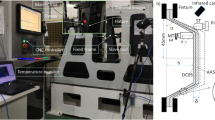Abstract
A novel incremental sheet forming process, friction-stir-assisted incremental sheet forming with synchronous bonding (FS-ISF&SB) using aluminum alloy and steel sheets was developed. The influences of stacking sequence, wall angle, ratio of rotational speed to feeding rate and step down on the forming and bonding quality, geometric profile, interface morphology and thickness distribution were investigated through a series of experiments. Experimental results demonstrate that FS-ISF&SB is specifically suitable for the fabrication laminated sheet metal parts. The part with good forming and bonding quality can be obtained with the stacking sequence as of S-A, wall angle as of 40°, rotational speed as of 3000 RPM, feeding rate as of 750 mm/min and step down as of 0.4 mm, respectively. Based on the scoring of various failure modes, five factors are listed in descending order of significance in forming and bonding quality as wall angle, step down, stacking sequence, rotational speed and ratio of rotational speed to feeding rate. A special geometric feature named as “bump structure” reveals the heterogeneous deformation. Results also indicate that the thickness distribution of the formed part does not conform to sine law, and the deviation from design model increases with the increasing of wall angle.












Similar content being viewed by others
References
A. Macwan, X.Q. Jiang, C. Li, and D.L. Chen, Effect of Annealing on Interface Microstructures and Tensile Properties of Rolled Al/Mg/Al Tri-Layer Clad Sheets, Mater. Sci. Eng. A, 2013, 587, p 344–351
L.Y. Sheng, F. Yang, T.F. Xi, C. Lai, and H.Q. Ye, Influence of Heat Treatment on Interface of Cu/Al Bimetal Composite Fabricated by Cold Rolling, Compos. B, 2011, 42(6), p 1468–1473
H.D. Manesh and A.K. Taheri, Bond Strength and Formability of an Aluminum-Clad Steel Sheet, J. Alloys Compd., 2003, 361(1), p 138–143
H. Huang, C. Ji, Z. Yang, and M. Yan, Implementation and Forming Mechanism of the Solid-Liquid Cast-Rolling Bonding (SLCRB) Process for Steel/Al Clad Pipes, J. Manuf. Process., 2017, 30, p 343–352
W. Deqing, S. Ziyuan, and Q. Ruobin, Cladding of Stainless Steel on Aluminum and Carbon Steel by Interlayer Diffusion Bonding, Scr. Mater., 2007, 56(5), p 369–372
K. Jin, Q. Yuan, J. Tao, J. Domblesky, and X. Guo, Analysis of the Forming Characteristics for Cu/Al Bimetal Tubes Produced by the Spinning Process, Int. J. Adv. Manuf. Technol., 2019, 101(1), p 147–155
N. Liu, L. Chen, Y. Fu, Y. Zhang, T. Tan, F. Yin, and C. Liang, Interfacial Characteristic of Multi-Pass Caliber-Rolled Mg/Al Compound Castings, J. Mater. Process. Technol., 2019, 267, p 196–204
L.J. Zhang, Q. Pei, J.X. Zhang, Z.-Y. Bi, and P.-C. Li, Study on the Microstructure and Mechanical Properties of Explosive Welded 2205/X65 Bimetallic Sheet, Mater. Des., 2014, 64, p 462–476
J.S. Yoon, S.H. Lee, and M.S. Kim, Fabrication and Brazeability of a Three-Layer 4343/3003/4343 Aluminum Clad Sheet by Rolling, J. Mater. Process. Technol., 2001, 111(1), p 85–89
S. Simões, A. Sofia Ramos, F. Viana, M. Teresa Vieira, and M.F. Vieira, TiAl Diffusion Bonding Using Ni/Ti Multilayers, Weld. World, 2017, 61(6), p 1267–1273
S. Niu, S. Ji, D. Yan, X. Meng, and X. Xiong, AZ31B/7075-T6 Alloys Friction Stir Lap Welding with a Zinc Interlayer, J. Mater. Process. Technol., 2019, 263, p 82–90
C. Wang, Y. Jiang, J. Xie, D. Zhou, and X. Zhang, Effect of the Steel Sheet Surface Hardening State on Interfacial Bonding Strength of Embedded Aluminum–Steel Composite Sheet Produced by Cold Roll Bonding Process, Mater. Sci. Eng. A, 2016, 652, p 51–58
T.N. Prasanthi, R.C. Sudha, and S. Saroja, Explosive Cladding and Post-Weld Heat Treatment of Mild Steel and Titanium, Mater. Des., 2016, 93, p 180–193
B. Li, Y. Shen, L. Luo, and W. Hu, Effects of Processing Variables and Heat Treatments on Al/Ti-6Al-4V Interface Microstructure of Bimetal Clad-Plate Fabricated via a Novel Route Employing Friction Stir Lap Welding, J. Alloys Compd., 2016, 658, p 904–913
K.P. Jackson, Incremental Forming of Sandwich Panels, J. Mater. Process. Technol., 2008, 204(1-3), p 290–303
K. Raghu Kandan, M. Rathinasabapathi, and P.V. Vaidyanathan, Explosive ‘form-cladding’—A Critical Study, J. Mater. Process. Technol., 1992, 32(1), p 65–71
J. Wang, H.-P. Wang, F. Lu, B.E. Carlson, and D.R. Sigler, Analysis of Al-Steel Resistance Spot Welding Process by Developing a Fully Coupled Multi-Physics Simulation Model, Int. J. Heat Mass Transf., 2015, 89, p 1061–1072
D. Xu, W. Wu, R. Malhotra, J. Chen, B. Lu, and J. Cao, Mechanism Investigation for the Influence of Tool Rotation and Laser Surface Texturing (LST) on Formability in Single Point Incremental Forming, Int. J. Mach. Tool Manuf., 2013, 73, p 37–46
A. Reilly, H. Shercliff, Y. Chen, and P. Prangnell, Modelling and Visualisation of Material Flow in Friction Stir Spot Welding, J. Mater. Process. Technol., 2015, 225, p 473–484
W. Li, J. Li, Z. Zhang, D. Gao, W. Wang, and C. Dong, Improving Mechanical Properties of Pinless Friction Stir Spot Welded Joints by Eliminating Hook Defect, Mater. Des., 2014, 62, p 247–254
Acknowledgments
The authors gratefully acknowledge financial support from the National Natural Science Foundation of China (51675332) and Program of Shanghai Excellent Academic Research Leadership (19XD1401900).
Author information
Authors and Affiliations
Corresponding author
Additional information
Publisher's Note
Springer Nature remains neutral with regard to jurisdictional claims in published maps and institutional affiliations.
Rights and permissions
About this article
Cite this article
Li, M., Wu, R., Cai, S. et al. Experimental Investigation on Friction-Stir-Assisted Incremental Forming with Synchronous Bonding of Aluminum Alloy and Steel Sheets. J. of Materi Eng and Perform 29, 750–759 (2020). https://doi.org/10.1007/s11665-020-04600-8
Received:
Revised:
Published:
Issue Date:
DOI: https://doi.org/10.1007/s11665-020-04600-8



